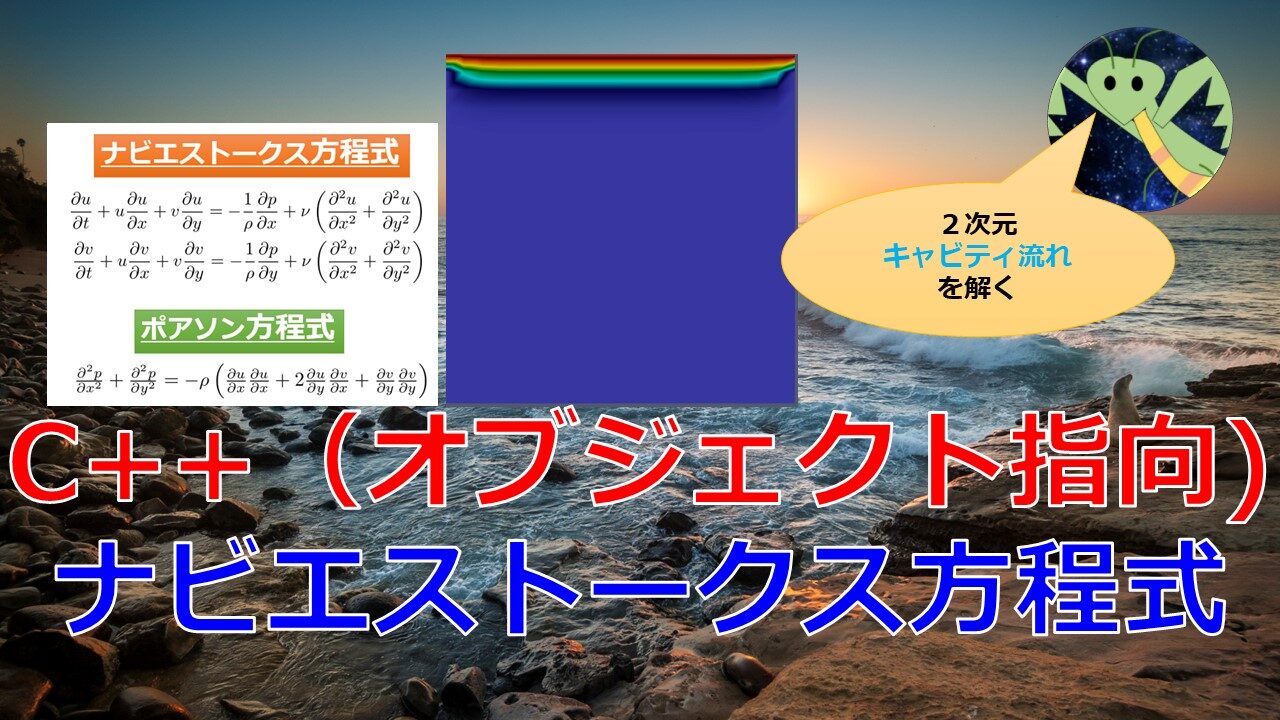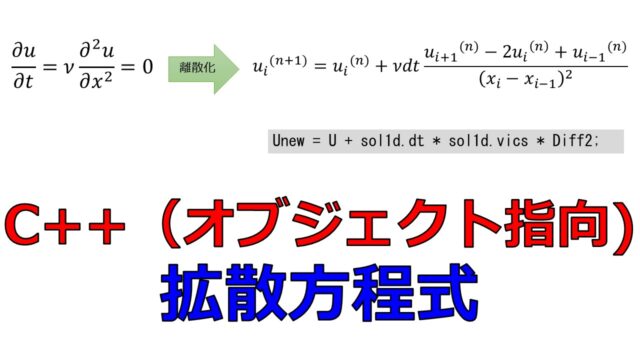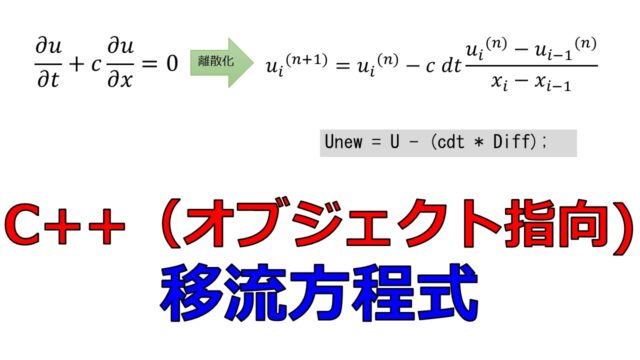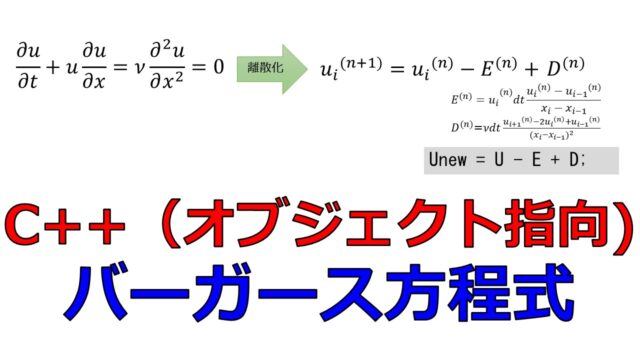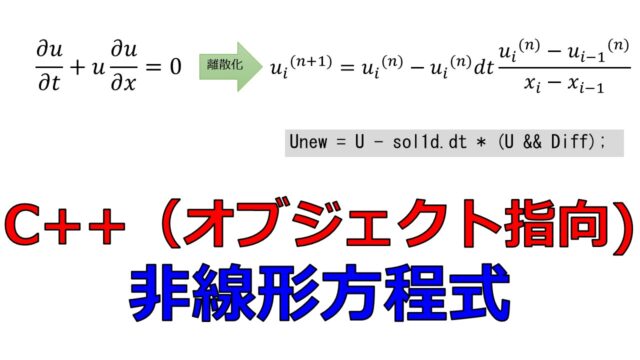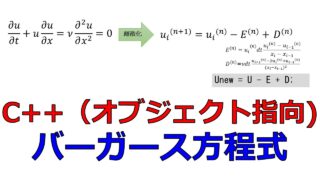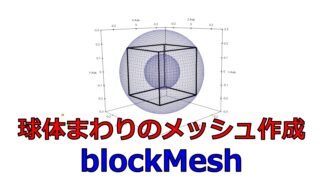利用するコード
こちらの1次元の移流方程式のコードをベースに2次元ナビエストークスの数値計算が行えるように修正していきます。
|
1 2 3 4 5 6 7 8 9 10 11 12 13 14 15 16 17 18 19 20 21 22 23 24 25 26 27 28 29 30 31 32 33 34 35 36 37 38 39 40 41 42 43 44 45 46 47 48 49 50 51 52 53 54 55 56 57 58 59 60 61 62 63 64 65 66 67 68 69 70 71 72 73 |
#include <iostream> #include <vector> #include "Mesh.h" //メッシュ設定 #include "Fields.h" //場の定義 #include "Diff1d.h" //空間微分 #include "Solution1D.h" //時間ループ #include "FileWriter.h" //ファイル出力 #include "PrintVector.h" //場のprint文 using namespace std; using std::vector; int main() { int Nx =100; double totallength = 2.0; Mesh mesh_(Nx, totallength);//Meshクラスのインスタンス化 //Fieldsの設定 #include "creatFields.h"; //initial condition cout << "Initial :: Iteration completed, writing the final file" << endl; for (int i = 0; i < U.size(); i++) { U[i].value = 1.0; if ((U[i].x1d > 0.5) && (U[i].x1d < 1.0)) { U[i].value = 2.0; } } Unew = U; string U_name = "Unew"; PrintVector(Unew, U_name); //file writer string name = "1dLinearConvec"; FileWriter filewriterObject_; filewriterObject_.write1dField(Unew, name); // solution int ntimestep = 500; double dt = 0.001; Solution1d sol1d(ntimestep, dt); for (int nt = 0; nt < sol1d.nt; nt++) { cout << "Iteration no : " << nt << endl; U= Unew; double wavespeed = 1.0; double cdt = sol1d.dt * wavespeed; Fields::vectorField1d Diff = fd1d::gradX1d(U); Unew = U - (cdt * Diff); // du/dt = c*du/dx => Unew{i} = U{i} - c*dt(u{i} - u{i-1})/dx // ノイマン条件 Unew[0].value = Unew[1].value; Unew[U.size() - 1].value = Unew[U.size() - 2].value; } //file writer string name2 = "1dLinearConvec_final"; FileWriter filewriterObject_1; filewriterObject_1.write1dField(Unew, name2); return 0; } |
creatFields.hを作ってUの設定は別のヘッダーファイルで定義するようにしました。
|
1 2 3 4 5 6 7 |
// UFields(typedef vector<Fields> vectorField1d;) Fields FieldsOperations; Fields::vectorField1d U(mesh_.NumberOfNode); Fields::vectorField1d Unew(mesh_.NumberOfNode); U = FieldsOperations.passGridinfomation(U, mesh_.xpts); Unew = FieldsOperations.passGridinfomation(Unew, mesh_.xpts); |
さらにプログラム作成途中でU[i].vauleの値を確認したい場合に出力するプログラムをヘッダーファイルに書きました。
main.cppで
|
1 2 |
//Fieldsの設定 #include "creatFields.h"; |
によりインクルードしています。
|
1 2 3 4 5 6 7 8 9 10 11 12 13 14 15 16 17 18 |
#include "Fields.h" #include <iostream> #include <string> void PrintVector(Fields::vectorField1d& vec, std::string& name) { std::cout << "====== " << name << ".x1d ====== " << std::endl; for (int i = 0; i < vec.size(); i++) { std::cout << name << "[" << i << "] = " << vec[i].x1d << std::endl; } std::cout << "====== " << name << ".value ====== " << std::endl; for (int i = 0 ; i < vec.size(); i++) { std::cout << name << "[" << i << "] = " << vec[i].value << std::endl; } } |
main.cppで
|
1 2 |
string U_name = "Unew"; PrintVector(Unew, U_name); |
の2行でよりでU[i].vauleの値を確認できます。
|
1 2 3 4 5 6 7 8 9 10 11 12 13 14 15 16 17 18 19 20 21 22 |
#ifndef MESH_H #define MESH_H #include "Mesh.h" #include <vector> using std::vector; class Mesh { public: Mesh(); //constructor Mesh(int&, double&); //引数ありconstructor virtual ~Mesh();//deconstructor int NumberOfNode;//x分割数 double lengthx;//x方向長さ double dx1d;//分割幅 vector<double> xpts;//x座標 void discritized1dgrid(vector<double>&); //x[i]の作成 }; #endif //MESH_H |
|
1 2 3 4 5 6 7 8 9 10 11 12 13 14 15 16 17 18 19 20 21 22 23 24 25 26 27 |
#include "Mesh.h" #include <iostream> Mesh::Mesh() { } Mesh::Mesh(int& n, double& txlengthx): NumberOfNode(n),//x分割数 lengthx(txlengthx),//x方向長さ xpts(NumberOfNode, 0.0)//vector(要素数, 値) { dx1d = lengthx / (NumberOfNode-1); discritized1dgrid(xpts); //add } void Mesh::discritized1dgrid(vector<double>& vec) { for (int i = 1; i < vec.size(); i++) //vec[0]=0なのでi=1からループする { vec[i] = vec[i - 1] + dx1d; } } Mesh::~Mesh() { } |
|
1 2 3 4 5 6 7 8 9 10 11 12 13 14 15 16 17 18 19 20 21 22 23 24 25 26 27 28 29 |
#ifndef FIELDS_H #define FIELDS_H #include "Mesh.h" #include <vector> using std::vector; class Fields { public: Fields();//constructor virtual ~Fields(); //deconstructor typedef vector<Fields> vectorField1d; double x1d; //x座標 double value; //Uの値 Fields::vectorField1d passGridinfomation(Fields::vectorField1d&, vector<double>&); //演算子のオーバーロード friend Fields::vectorField1d operator+(const Fields::vectorField1d&, const Fields::vectorField1d&); friend Fields::vectorField1d operator-(const Fields::vectorField1d&, const Fields::vectorField1d&); friend Fields::vectorField1d operator&&(const Fields::vectorField1d&, const Fields::vectorField1d&); friend Fields::vectorField1d operator*(const double&, const Fields::vectorField1d&); friend Fields::vectorField1d operator*(const Fields::vectorField1d&, const double&); }; #endif //FIELDS_H |
|
1 2 3 4 5 6 7 8 9 10 11 12 13 14 15 16 17 18 19 20 21 22 23 24 25 26 27 28 29 30 31 32 33 34 35 36 37 38 39 40 41 42 43 44 45 46 47 48 49 50 51 52 53 54 55 56 57 58 59 60 61 62 63 64 65 66 67 68 69 70 71 72 73 74 75 76 77 78 79 80 81 82 |
#include "Fields.h" #include <iostream> Fields::Fields(): x1d(0.0), value(2.0) { } Fields::vectorField1d Fields::passGridinfomation(Fields::vectorField1d& vec, vector<double>& xpts_) { /* typedef vector<Fields> vectorField1d; double value; double x1d; */ for (int i = 0; i < vec.size(); i++) { vec[i].x1d = xpts_[i]; } return vec; } Fields::vectorField1d operator+(const Fields::vectorField1d& vecA, const Fields::vectorField1d& vecB) { Fields::vectorField1d temp = vecA; for (int i = 0; i < vecA.size(); i++) { temp[i].value += vecB[i].value; } return temp; } Fields::vectorField1d operator-(const Fields::vectorField1d& vecA, const Fields::vectorField1d& vecB) { Fields::vectorField1d temp = vecA; for (int i = 0; i < vecA.size(); i++) { temp[i].value -= vecB[i].value; } return temp; } Fields::vectorField1d operator&&(const Fields::vectorField1d& vecA, const Fields::vectorField1d& vecB) { Fields::vectorField1d temp = vecA; for (int i = 0; i < vecA.size(); i++) { temp[i].value *= vecB[i].value; } return temp; } Fields::vectorField1d operator*(const double& dbvalue, const Fields::vectorField1d& vecB) { Fields::vectorField1d temp = vecB; for (int i = 0; i < vecB.size(); i++) { temp[i].value = dbvalue * vecB[i].value; } return temp; } Fields::vectorField1d operator*(const Fields::vectorField1d& vecB, const double& dbvalue) { Fields::vectorField1d temp = vecB; for (int i = 0; i < vecB.size(); i++) { temp[i].value = dbvalue * vecB[i].value; } return temp; } Fields::~Fields() { } |
|
1 2 3 4 5 6 7 8 9 10 11 12 13 14 15 16 17 18 19 20 21 22 |
#include "Fields.h" #include <vector> using std::vector; namespace fd1d { // U U U U //*-----*----*----* // i-1 i Fields::vectorField1d gradX1d(Fields::vectorField1d& vec) { Fields::vectorField1d temp = vec; for (int i = 1; i < vec.size(); i++) { temp[i].value = (vec[i].value - vec[i - 1].value) / (vec[i].x1d - vec[i - 1].x1d); } return temp; } } |
|
1 2 3 4 5 6 7 8 9 10 11 12 13 14 |
#ifndef SOLUTION_H #define SOLUTION_H class Solution1d { public: Solution1d(int&, double&); // constructor virtual ~Solution1d(); //deconstructor int nt; //ステップ数 double dt; //時間刻み幅 }; #endif |
|
1 2 3 4 5 6 7 8 9 10 11 12 13 |
#include <iostream> #include "Solution1D.h" Solution1d::Solution1d(int& nt_, double& dt_) : nt(nt_), dt(dt_) { std::cout << "Solution1d()" << std::endl; } Solution1d::~Solution1d() { } |
|
1 2 3 4 5 6 7 8 9 10 11 12 13 14 15 16 17 18 19 20 21 22 23 24 25 |
#ifndef FILEWRITWE_H #define FILEWRITWE_H #include <stdio.h> #include <iostream> #include <vector> #include <cmath> #include <string> #include <cstring> #include <sstream> #include <fstream> //ファイルの書き込みに必要 #include "Fields.h" using namespace std; using std::vector; using std::string; class FileWriter { public: FileWriter();//constructor virtual ~FileWriter(); //destructor void write1dField(Fields::vectorField1d&, string&); }; #endif |
|
1 2 3 4 5 6 7 8 9 10 11 12 13 14 15 16 17 18 19 20 21 22 23 24 25 26 27 28 29 30 31 32 33 34 35 36 37 38 39 |
#include "FileWriter.h" #include <iostream> FileWriter::FileWriter() { } void FileWriter::write1dField(Fields::vectorField1d& vec, string& name_) { string myfileType = ".dat"; //拡張子 string path = "C:\\work\\C_lang\\20220413_diff_C_puls\\\004_NS_Eq_1D_blog\\1DNS\\1DNS\\"; //絶対パス string pathName = path.append(name_).append(myfileType); //"myOutput;" + ".dat" => "myOutput.dat" std::cout << "pathName = " << pathName << " : pathName.size() = " << pathName.size() << std::endl; FILE* outfile; fopen_s(&outfile, pathName.c_str(), "w+t"); //https://www.paveway.info/entry/2018/12/25/cpp_std_string_char std::cout << "outfile = " << &outfile << std::endl; for (int i = 0; i < vec.size(); i++) { double xpos = vec[i].x1d; double uvel = vec[i].value; if (outfile) { fprintf(outfile, "%5.8lf\t%5.8lf\n", xpos, uvel); } } fclose(outfile); } FileWriter::~FileWriter() { } |
こちらのコードをベースに修正していきます。
解くべき方程式の確認(ナビエストークス方程式とポアソン方程式)
今回解析するのはキャビティ流れと呼ばれる流れです。
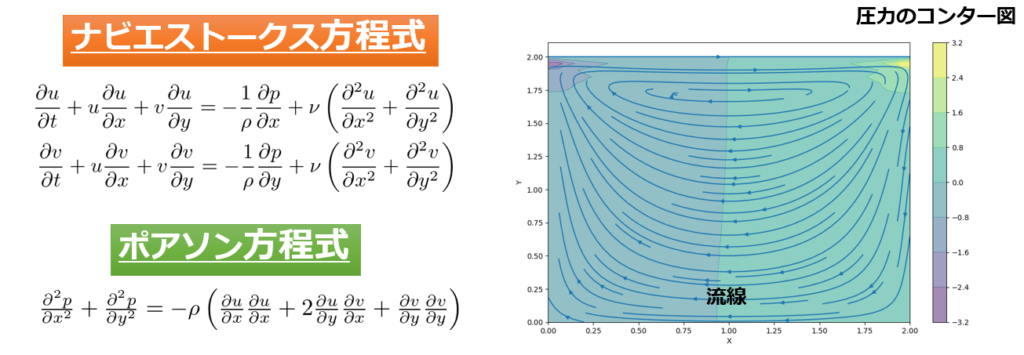
Pythonでもキャビティ流れを行ったのが下記の記事です。
C++はわからなくてもPythonならわかるという方には良い内容です。
まずは、今回「解くべき方程式」と「変数」が何かを確認しておきましょう。
もっと詳しく勉強したい方は☟こちらの記事を参考にしてください。
今回は、2次元で計算を行うため少々くどいですが、成分ごとの式を書き下すことにします。
&\frac{\partial }{\partial x}\frac{\partial u}{\partial t}+\frac{\partial u}{\partial x}\frac{\partial u}{\partial x}+u\frac{\partial^2 u}{\partial x^2}+ \frac{\partial v}{\partial x}\frac{\partial u}{\partial y}+v\frac{\partial^2 u}{\partial x\partial y} \\
&= -\frac{1}{\rho}\frac{\partial^2 p}{\partial x^2}+\nu \frac{\partial }{\partial x}\left(\frac{\partial^2 u}{\partial x^2}+\frac{\partial^2 u}{\partial y^2} \right)\tag{6}
\end{align*}
&\frac{\partial }{\partial y}\frac{\partial v}{\partial t}+\frac{\partial u}{\partial y}\frac{\partial v}{\partial x}+u\frac{\partial^2 v}{\partial y\partial x}+ \frac{\partial v}{\partial y}\frac{\partial v}{\partial y}+v\frac{\partial^2 v}{\partial x\partial y^2} \\
&=-\frac{1}{\rho}\frac{\partial^2 p}{\partial y^2}+\nu \frac{\partial }{\partial y}\left(\frac{\partial^2 u}{\partial x^2}+\frac{\partial^2 u}{\partial y^2} \right)\tag{7}
\end{align*}
\frac{\partial^2 p}{\partial x^2}+\frac{\partial^2 p}{\partial y^2} = -\rho\left(\frac{\partial u}{\partial x}\frac{\partial u}{\partial x}+2\frac{\partial u}{\partial y}\frac{\partial v}{\partial x}+\frac{\partial v}{\partial y}\frac{\partial v}{\partial y} \right)\tag{8}
\end{align*}
解くべき方程式の離散化
& \frac{u_{i,j}^{n+1}-u_{i,j}^{n}}{\Delta t}+u_{i,j}^{n}\frac{u_{i,j}^{n}-u_{i-1,j}^{n}}{\Delta x}+v_{i,j}^{n}\frac{u_{i,j}^{n}-u_{i,j-1}^{n}}{\Delta y} = \\
& \qquad -\frac{1}{\rho}\frac{p_{i+1,j}^{n+1}-p_{i-1,j}^{n+1}}{2\Delta x}+\nu\left(\frac{u_{i+1,j}^{n}-2u_{i,j}^{n}+u_{i-1,j}^{n}}{\Delta
x^2}+\frac{u_{i,j+1}^{n}-2u_{i,j}^{n}+u_{i,j-1}^{n}}{\Delta y^2}\right)\tag{9}
\end{align*}
&\frac{v_{i,j}^{n+1}-v_{i,j}^{n}}{\Delta t}+u_{i,j}^{n}\frac{v_{i,j}^{n}-v_{i-1,j}^{n}}{\Delta x}+v_{i,j}^{n}\frac{v_{i,j}^{n}-v_{i,j-1}^{n}}{\Delta y} = \\
& \qquad -\frac{1}{\rho}\frac{p_{i,j+1}^{n+1}-p_{i,j-1}^{n+1}}{2\Delta y}+\nu\left(\frac{v_{i+1,j}^{n}-2v_{i,j}^{n}+v_{i-1,j}^{n}}{\Delta x^2}+\frac{v_{i,j+1}^{n}-2v_{i,j}^{n}+v_{i,j-1}^{n}}{\Delta y^2}\right)\tag{10}
\end{align*}
\frac{p_{i+1,j}^{n+1}-2p_{i,j}^{n+1}+p_{i-1,j}^{n}}{\Delta x^2}+\frac{p_{i,j+1}^{n+1}-2p_{i,j}^{n+1}+p_{i,j-1}^{n+1}}{\Delta y^2} = b_{i,j}^{n}\tag{11.1}
\end{align*}
b_{i,j}^{n} = \rho \left[-\frac{u_{i+1,j}^{n}-u_{i-1,j}^{n}}{2\Delta x}\frac{u_{i+1,j}^{n}-u_{i-1,j}^{n}}{2\Delta x}\\
– 2\frac{u_{i,j+1}^{n}-u_{i,j-1}^{n}}{2\Delta y}\frac{v_{i+1,j}^{n}-v_{i-1,j}^{n}}{2\Delta x}\\
– \frac{v_{i,j+1}^{n}-v_{i,j-1}^{n}}{2\Delta y}\frac{v_{i,j+1}^{n}-v_{i,j-1}^{n}}{2\Delta y}\right]\tag{11.2}
\end{align*}
※非圧縮過程なので$\nabla \cdot \boldsymbol{v}=\frac{\partial u}{\partial x}+\frac{\partial v}{\partial y}=0$
どういった離散化をしているのかを以下でまとめておきました。

これで離散化は完了ですが、知りたいのは\(n+1\)ステップでの格子点\(i,j\)の流速\(u^{n+1}_{ij}\)、\(v^{n+1}_{ij}\)、圧力\(p^{n+1}_{ij}\)ですので、
u_{i,j}^{n+1} = u_{i,j}^{n} & – u_{i,j}^{n} \frac{\Delta t}{\Delta x} \left(u_{i,j}^{n}-u_{i-1,j}^{n}\right) – v_{i,j}^{n} \frac{\Delta t}{\Delta y} \left(u_{i,j}^{n}-u_{i,j-1}^{n}\right) \\
& – \frac{\Delta t}{\rho 2\Delta x} \left(p_{i+1,j}^{n}-p_{i-1,j}^{n}\right) \\
& + \nu \left(\frac{\Delta t}{\Delta x^2} \left(u_{i+1,j}^{n}-2u_{i,j}^{n}+u_{i-1,j}^{n}\right) + \frac{\Delta t}{\Delta y^2}
\left(u_{i,j+1}^{n}-2u_{i,j}^{n}+u_{i,j-1}^{n}\right)\right)\tag{12}
\end{align*}
v_{i,j}^{n+1} = v_{i,j}^{n} & – u_{i,j}^{n} \frac{\Delta t}{\Delta x} \left(v_{i,j}^{n}-v_{i-1,j}^{n}\right) – v_{i,j}^{n} \frac{\Delta t}{\Delta y} \left(v_{i,j}^{n}-v_{i,j-1}^{n})\right) \\
& – \frac{\Delta t}{\rho 2\Delta y} \left(p_{i,j+1}^{n+1}-p_{i,j-1}^{n+1}\right) \\
& + \nu \left(\frac{\Delta t}{\Delta x^2} \left(v_{i+1,j}^{n}-2v_{i,j}^{n}+v_{i-1,j}^{n}\right) + \frac{\Delta t}{\Delta y^2}
\left(v_{i,j+1}^{n}-2v_{i,j}^{n}+v_{i,j-1}^{n}\right)\right)\tag{13}
\end{align*}
p_{i,j}^{n+1}=\frac{(p_{i+1,j}^{n+1}+p_{i-1,j}^{n+1})\Delta y^2+(p_{i,j+1}^{n+1}+p_{i,j-1}^{n+1})\Delta x^2-b_{i,j}^{n}\Delta x^2\Delta y^2}{2(\Delta x^2+\Delta y^2)}
\tag{14.1}
\end{align*}
b_{i,j}^{n} = \rho\left[-\frac{u_{i+1,j}^{n}-u_{i-1,j}^{n}}{2\Delta x}\frac{u_{i+1,j}^{n}-u_{i-1,j}^{n}}{2\Delta x}\\
-2\frac{u_{i,j+1}^{n}-u_{i,j-1}^{n}}{2\Delta y}\frac{v_{i+1,j}^{n}-v_{i-1,j}^{n}}{2\Delta x}-\\
\frac{v_{i,j+1}^{n}-v_{i,j-1}^{n}}{2\Delta y}\frac{v_{i,j+1}^{n}-v_{i,j-1}^{n}}{2\Delta y}\right]\tag{14.2}
\end{align*}
その前に、初期状態と境界条件を設定
数値計算をはじめるまえに、初期状態と境界条件を設定する必要があります。
- \(u, v, p = 0\)
- \(u=1\) at \(y=2\)
- \(u, v=0\) その他
- \(\frac{\partial p}{\partial y}=0\) at \(y=0\)
- \(p=0\) at \(y=2\)
- \(\frac{\partial p}{\partial x}=0\) at \(x=0,2\)
言葉だけではよくわからないかと思いますので、絵を作成しました。
今回解析するのは「キャビティ流れ」と呼ばれる流れです。
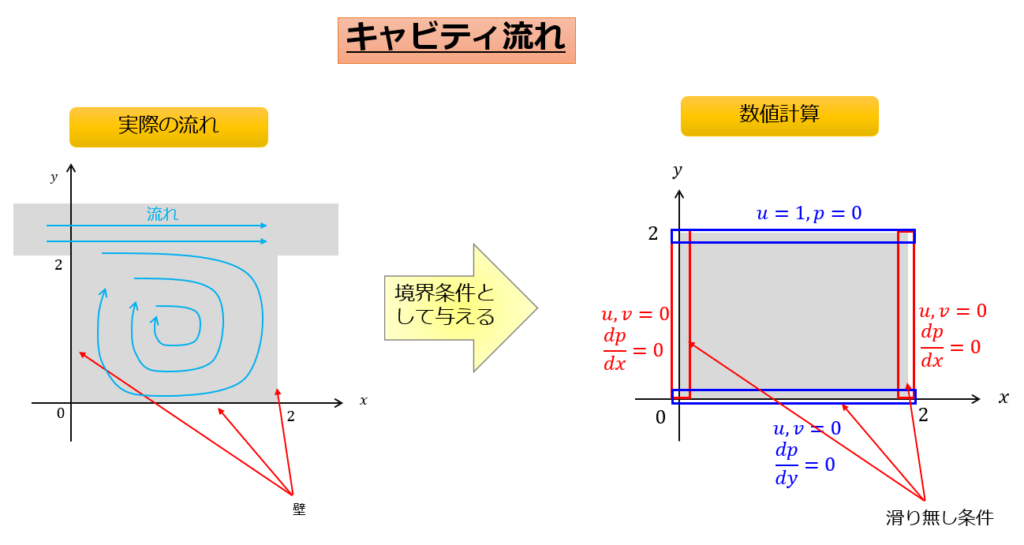
※ちなみに、圧力の基準圧を\(p=0\)としています。
なので、境界条件として\(y=0\)の圧力は\(p=0\)としています。
非圧縮条件で式を解く場合は、圧力の微分の項のみしか意味がないので、基準値は何でもいいんですよね。だから、もし考えている系の基準圧を大気圧(101.25Paくらい)としている場合に、わざわざ境界条件を\(p=101.325kPa\)とする必要はありません。
境界条件に\(p=0\)としておいて、計算された圧力分布は基準圧に対してどうなのかを考えればいいだけです。
(基準圧が\(p=101.325kPa\)なら、分布に\(p=101.325kPa\)を足せばいいだけという意味です)
流体解析に関する境界条件の考え方は非常に見ずかしいので、扱う現象に応じて自身で境界条件を考える必要があります。
ここでは、詳しくは解説しませんが(体系的に解説できるほどの知識もないですが_(._.)_)以下の記事が参考になると思います。
では、以下で実際にナビエストークス方程式とポアソン方程式を連立させながらGoogle Colaboratoryを使ってPythonのコードを書いていきましょう。
キャビティ流れを解く手順(フロー)
ナビエストークス方程式、およびナビエストークス方程式の発散と連続の式から得られる圧力方程式を連立して計算を行います。
